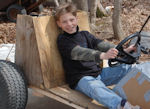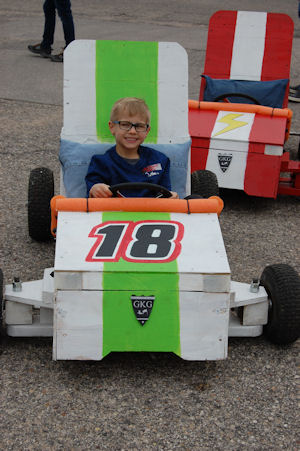I have been actively shopping for a low cost 3-d printer for almost 2 years now. At first when I was looking all that was available were wooden versions and semi plastic versions. I have been looking at reviews and examining the best possible values out there.
My consensus: a Solidoodle. My concern when looking at the lowest cost versions out there were they are made out of wood, and had an x-y mechanisms that to me was not solid enough for good consistent parts. The reviews on-line tallied that up too.
I will admit that when we opened the box and started trying to make parts, that I went to bed upset and a little disappointed. The problem was two fold:
– First we couldn’t get parts to stick to the bed
– Second the machine was not making round parts, and they were not even to scale properly.
After about a week of futzing, my boys and I figured out the sweet spot for making parts. It really is simple:
1.) Take off the special Kapton tape and use a slurry of ABS and Acetone. Basically you make your own bed that is as thin as you want it to be and adheres magnificiently to the aluminum bed. Also it does not appear you need to run the heated bed, but it doesn’t hurt.
2.) Run the parts on a lower setting per layer. The unit automatically slows down and that takes care of the out of round parts. Also we reset the y axis, but we are not sure if that was needed.
Now the machine is fantastic. I love the way it is made, the durable nature of it makes it stay in line (or square). We have run the machine for about 10 to 15 hours now and it still is making good parts.
The biggest problem that I can see with the 3-d printers out there is that the parts won’t stick to the platform, due to the adhesion issues. Typically a raft will be put down, but that too comes up because it is relying on a thermal/mechanical adhesion.
The problem is fundamental. When ever you use glues on two opposing surfaces to get the best adhesion they recommend roughing the surface up. The reason for this is to give the glue something to bite into. Glue relies on micro-valleys in the material to make a mechanical bond.
The same applies with 3-d printer bases. A liquid will penetrate better into a surface, than a piece of hot gooey plastic. In fact, the thinner ABS-Acetone material acts like a paint and uses capillary action to suck the mixture into the surface of 3-d printer base. We had such a good adhesion at first that the Kapton tape came up. I think also that the Kapton tape probably dissolves eventually in the acetone as well. Not sure the rationale behind the Kapton tape, because we could not get anything to stick to it.
The ABS-Acetone mixture however, is just the answer. It acts like a micro layer of plastic that gives the part something to melt to. Essentially the whole plate when coated with the ABS-slurry becomes a raft and holds the parts down and keeps it from lifting. (You will discover a third problem with parts is that they want to peal up due to the shrinkage of the material. I am not sure if the ABS-Slurry will entirely cure this, especially with larger platforms, but it will definitely keep the part bonded to the base better.)
The software for the Solidoodle actually works quite well. I am a techy type guy so it took a little playing with it to discover what it can do. Any program really just requires working with it. They have on line videos and those were helpful. So be sure to avail yourself of their videos right away. If I were to make a comment about improving the Solidoodle it would be that the instructions should be a little bit more full. Not that they were insufficient, but to use the software perhaps a video link or something.
A 3-d printer opens up a whole new dimension that was not possible with our CNC mill. The CNC mill requires a lot of thought on how you are going to place the part, what tools you are going to use to rough out the part and so on. It also makes a ton of noise and eats up a lot of motor electricity. When I am working on getting a rough idea about a prototype and whether it works, the 3-d printer will get it done in a few hours at a click of a mouse.
The other day, I woke up and started the Solidoodle. Let the unit warm up and had breakfast. Came down after breakfast, and loaded up a model and went to work. The kids later that day took the model off and gave me a report one what happened with the part.
The other day for example we designed a potential product in one day. Outside our house is a ground post that the house is hooked too. It is first off an eyesore and two a potential hazard. I asked my 13 year old son to model it up on our 3-d software (Alibre) and then show it to me. We sat together on the couch and refined the model. Then we ran it just before bed. By 11:00 the model was done.
The next morning we tried it out, painted it and put it in place. Now we can refine the model to make it stronger if need be. We designed and developed a product in two days. Without a 3-d printer prototyping it could potentially have cost thousands of dollars, with little tweaking available.
So needless to say, I am pleased with the printer and most especially how much value I received. The Solidoodle is a 500 dollar unit (plus shipping). We opted for the unit with the heated table. In retrospect I still would get the heated table, I think it does help keep parts on the table, even with the ABS-Slurry.
If you are a family with kids who love to tinker, a good investment would be some 3-d software and a 3-d printer. Oh and by the way I was going to make my own unit, but after looking at the Solidoodle and the complexity of it, I would suggest just buying a unit, the headaches you will save might be worth the 500 dollars after all. To me the object is making parts….so that’s what we are doing. Maybe we will print out parts for our next machine….hmmmm.


